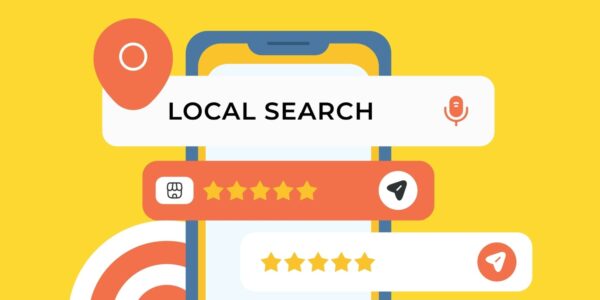Local search has become one of the most powerful ways for small businesses to compete with larger players. For example, when someone searches “coffee shop near me” or “best accountant in Manchester,” they’re ready to act and often looking for businesses like yours. That’s where local SEO (Search Engine Optimisation) comes in.
Unlike traditional advertising, local SEO meets customers at the exact moment they need your services. It puts your business in front of people actively searching, not passively scrolling. This levels the playing field for startups and independent companies, and you don’t need a national budget to get noticed locally. What you do need is a clear strategy that ensures your business shows up in the right place, at the right time.
In this guide, we’ll demystify how local SEO works and show you exactly how to get your business found. Whether you’ve just launched your company or looking to grow, you’ll learn local SEO tips like how to make your business visible in local search results, Google Maps, and Google Business Profile listings.
Key takeaways
- Local SEO improves visibility by helping small businesses appear in geographically relevant searches like Google Maps and “near me” results, ensuring they reach customers actively looking for their services.
- Optimising a Google Business Profile, maintaining consistent NAP details, and collecting customer reviews are essential for building trust and ranking higher in local search.
- Implementing local SEO strategies (such as publishing location-based content, earning local backlinks, and ensuring mobile-friendly design) is a cost-efficient way for startups to compete with larger, established competitors.
What is local SEO, and why does it matter?
Put simply, local SEO helps you appear when nearby customers search for what you offer. For startups and SMEs, it’s one of the most effective ways to capture customers in your immediate area.
Unlike traditional SEO, which targets national or global visibility, local SEO focuses on proximity – helping you show up to the people most likely to walk through your door or book your services. Let’s take a closer look at the difference between local SEO and national SEO.
Key differences between local and national SEO
While national SEO is about building broad digital authority, local SEO relies heavily on location-based factors. If you run a bakery in Bristol, it’s far more valuable to show up when someone nearby searches “bakery near me” than to try to rank nationally for “UK’s best bakery”.
- 11 festive marketing ideas for small businesses in 2025
- Top 5 project management tools for small businesses
- 4 best social media management tools for SMEs
National SEO typically requires significant time, backlinks, and domain authority to compete. Local SEO, on the other hand, gives startups and smaller businesses a faster route to visibility because Google prioritises proximity and local relevance over sheer company size.
Why is local SEO important for new companies?
For new businesses, visibility is everything. You may not yet have the brand recognition or resources to compete nationally, but local SEO helps you get found quickly by nearby customers who are ready to buy. This makes it an essential SEO strategy for startups.
According to Artios, 76% of people who conduct a local search visit a business within 24 hours, and 28% of those searches result in a purchase. That means optimising locally doesn’t just improve your ranking, it can directly impact foot traffic and sales.
Local SEO also builds credibility. A complete Google Business Profile with reviews, photos, and accurate details signals professionalism and trust, allowing startups to win over customers before larger competitors.
Another reason local SEO is so powerful is that Google’s algorithm is designed to reward businesses that demonstrate proximity, relevance, and authority. Understanding these three pillars is the first step in ensuring your company appears in the right searches.
How Google uses proximity, relevance and authority
When people search for businesses nearby, Google doesn’t just serve results based on distance alone. Its local search algorithm weighs multiple factors to ensure the most useful, trustworthy, and relevant results rise to the top.
This means that even if a competitor is physically closer to the searcher, you can still outrank them by strengthening other signals. Google frames these signals around three main pillars:
- Proximity – How close your business is to the searcher
- Relevance – How well your listing matches the search intent
- Authority (or prominence) – How trustworthy and established your business appears online, based on reviews, citations, and backlinks
You might assume that being closest to the searcher guarantees you a top ranking, but that’s not always true. A business two miles away with glowing reviews can outrank one down the road with weak or missing information.
How to increase your online visibility with local SEO
Now that you know what drives local search, let’s look at how to put it into practice. These steps will help your business appear in Google Maps listings and organic search results.
1. Claim & optimise your Google Business profile
Your Google Business Profile (GBP) is the cornerstone of local SEO. Without it, your business may not even appear in local searches. To maximise its impact:
- Add complete business details: name, category, address, phone number, opening hours, and website
- Upload high-quality photos of your premises, team, and products
- Use posts to share updates, offers, or events
- Collect and respond to customer reviews regularly
Think of your GBP as a digital shopfront. The more inviting and informative it looks, the more likely customers will engage. Businesses with complete profiles are 70% more likely to attract in-person visits.
2. Ensure NAP consistency
In local SEO, NAP stands for Name, Address, and Phone Number, which are essential business contact details. Your NAP should appear the same everywhere your business appears online. However, one of the most common local SEO issues is inconsistent business information across platforms. Search engines cross-reference your details from your website, Google profile, and third-party directories. If your address or phone number differs, it can reduce your credibility.
To stay consistent:
- Use the exact same format for your business name everywhere
- Double-check your address (especially abbreviations like “Rd” vs “Road”)
- Ensure your phone number matches across listings
If you’re a busy founder, you’ll now know how crucial it is to maintain consistent listings across various platforms, but finding the time to update each one manually might seem overwhelming. That’s where directory management tools like Moz Local and Yext come in. These platforms automate consistency, so no need to worry about outdated information.
3. Get listed on high-authority local directories
Directory listings (also known as “citations”) are still valuable for building local authority. Platforms like Yell, Thomson Local, and Yelp UK provide signals to Google that your business is legitimate. When choosing where to list, don’t stop at directories. Look for partnerships with local chambers of commerce, trade associations, or regional business networks. These links often carry more authority than generic listings.
Here’s how to make those directory listings work in your favour:
- Always use the same NAP details
- Choose relevant industry directories in addition to general ones
- Avoid low-quality or spammy directories – they can do more harm than help
Local SEO tools like BrightLocal offer citation tracking and review monitoring so you can see how your business currently performs in search results. Whitespark’s Citation Finder helps you discover which directories your competitors are using, so you don’t miss out on valuable opportunities.
Common local SEO mistakes to avoid
Even with the best intentions, many startups make mistakes that undermine their local SEO efforts. Let’s explore the most common missteps and how to correct them.
Incomplete Google profile
Leaving sections of your GBP blank signals to Google that your listing isn’t as strong as competitors. Missing photos, categories, or service details can push you down in rankings. Always aim for 100% completeness. Use the free Google Business Profile Manager to check for missing fields and updates.
Inconsistent NAP details
Inconsistent NAP details are one of the most common issues. Even a small formatting error can confuse Google and frustrate customers. Conflicting details confuse search engines and customers alike.
Audit your online presence every few months to ensure accuracy. Moz local and BrightLocal scan directories and listings to highlight inconsistencies in your NAP. Correcting these errors improves your visibility and builds trust with potential customers.
Ignoring mobile UX
Over 60% of local searches happen on mobile devices. If your website isn’t mobile-friendly, potential customers will bounce quickly – and Google will take note. Responsive design and fast load times are critical. Test your site using a mobile-friendly test tool. Fixing these issues now helps you keep visitors on your site longer and gives Google more reason to boost your visibility.
Ready to boost your visibility?
Local SEO focuses on making your business easy to find and even easier to choose when customers are ready to act. For startups, mastering local SEO means levelling the playing field against bigger brands. Try these strategies over the next few weeks, and you’ll earn more in-person visits, calls, and customers in your area – hopefully, you’ll see improved rankings, too.
Establishing credibility for your business is a key step to earning a higher local SEO ranking. Why not start by registering your company and getting a business address to ensure your brand appears professional and trustworthy? Start your journey with Quality Company Formations today.
Frequently asked questions
Please note that the information provided in this article is for general informational purposes only and does not constitute legal, tax, or professional advice. While our aim is that the content is accurate and up to date, it should not be relied upon as a substitute for tailored advice from qualified professionals. We strongly recommend that you seek independent legal and tax advice specific to your circumstances before acting on any information contained in this article. We accept no responsibility or liability for any loss or damage that may result from your reliance on the information provided in this article. Use of the information contained in this article is entirely at your own risk.














Join The Discussion